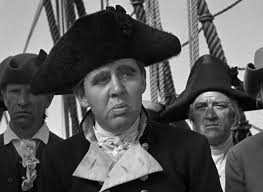May 4, 2018
The first two movies made about the Bounty Mutiny debuted in 1916 and 1933 but it is the three latter versions that are the most famous. Because of the story’s allure, the greatest stars of their generations sought out and secured lead roles. Imagine being in charge of casting. Are you going to have the courage to turn down Hannibal Lector, Vito Corleone, or Quasimodo (Charles Laughton)? Would you want to break the news to Quasimodo’s wife, the Bride of Frankenstein (Elsa Lancaster)?
1935 Version
Wallace Beery turned down the role of Captain Bligh because Beery despised Clark Gable who had been cast as Christian Fletcher. Beery’s rejection created a great opportunity for Producer Irving Thalberg. The producer knew that Gable would be appalled by Charles Laughton’s homosexuality and thus add fuel to their on-camera hostilities. Gable was a homophobe who not only was offended by Laughton’s bringing his boyfriend to the set but also resented Laughton’s classical Shakespherian training. It should be noted that despite his homosexuality, Laughton and Elsa Lancaster enjoyed a very happy marriage.
Laughton was violently seasick throughout most of the filming however he gave a memorable performance which he attributed to his coming from a long line of mariners. When Laughton told this to George S Kaufman, the humorist said “I assume, then, that you also came from a long line of hunchbacks?”
Gable would later say that “Mutiny” was the best movie he ever starred in. The film is rated in the top 100 American movies by the American Film Institute
1962 Movie Bottom of Form
The production and financial troubles of the 1962 production can be summarized in two words: Marlon Brando
Brando’s effect on the movie began four years before filming. In 1958, MGM announced that the legendary John Sturges would be directing Spencer Tracy as Bligh and Burt Lancaster as Christian. When the studio decided to substitute Brando, Sturges quit. After arduous negotiations, Brando signed for a record $500,000 plus five thousand dollars a day if shooting went over-schedule. He turned down lead roles in Lawrence of Arabia and Cleopatra in order to play Christian.
From the start, Brando alienated his castmates with his chronic tardiness and boorishness. He would improvise his lines with Trevor Howard who played Bligh, preventing Howard from picking up his cues. On occasion, Brando would put cotton in his ears so he couldn’t hear Howard’s lines. Howard said that Brando “could drive a saint to hell in a dogsled.”
During filming, Brando questioned every line in the script and demanded constant re-writes. Consequently, filming rarely began before noon even though the rest of the cast had been on the hot tropical set since dawn. Two months into filming, Brando proposed that he play the ship’s botanist rather than Christian.
The emerging star Richard Harris took a third-billed role in order to work with Brando but he soon came to loathe the diva. Towards the end of filming, Harris refused to act with Brando. In Christian’s death scene, Harris talked to a log rather than address the star. That scene was directed by an assistant, as Director Lewis Milestone could no longer tolerate Brando. It should be noted that Milestone was a substitute director as Carol Reed already had been sacked for demanding that the troublesome actor be fired.
Milestone estimated that 6M of the film’s record 19M budget could be attributed to Brando’s production delays. The film barely broke even and Brando’s career cratered. He would not regain his star power until 1972’s epic Godfather.
1984
“The Bounty” is considered to be the most historically accurate of the three films and compared to the other two had the least on-set drama. Unlike most water-based films, “The Bounty” came in on time and under budget despite horrendous weather conditions.
Christopher Reeve was the first choice to play Christian over Mel Gibson and Sting. However Reeve turned down the offer saying that Gibson was a better fit for the role. The constant weather delays played to Gibson’s dark side and he would go on drunken binges. One day he could only be filmed from one side because of injuries sustained in a bar fight. Sir Anthony Hopkins the recovering alchoholic who played Captain Bligh observed “Mel is a wonderful, wonderful fellow with a marvelous future but he’s in danger of blowing it, unless he takes hold of himself.” Gibson agreed with Hopkin’s concern and would eventually give up the bottle. Gibson greatly admired Hopkins as a man and claimed that Hopkin’s performance was “the best aspect of the film”.
While Gibson was pleased that the film tried to accurately portray the characters and the mutiny he felt that the film fell short saying ” In the old version, Captain Bligh was the bad guy and Fletcher Christian was the good guy. But really Fletcher Christian was a social climber and an opportunist. They should have made him the bad guy, which indeed he was”.
Have a great weekend and have a beer for Mel and Tony.
If you are looking for top-notch marketing support contact ted@blackdotmessaging.com

